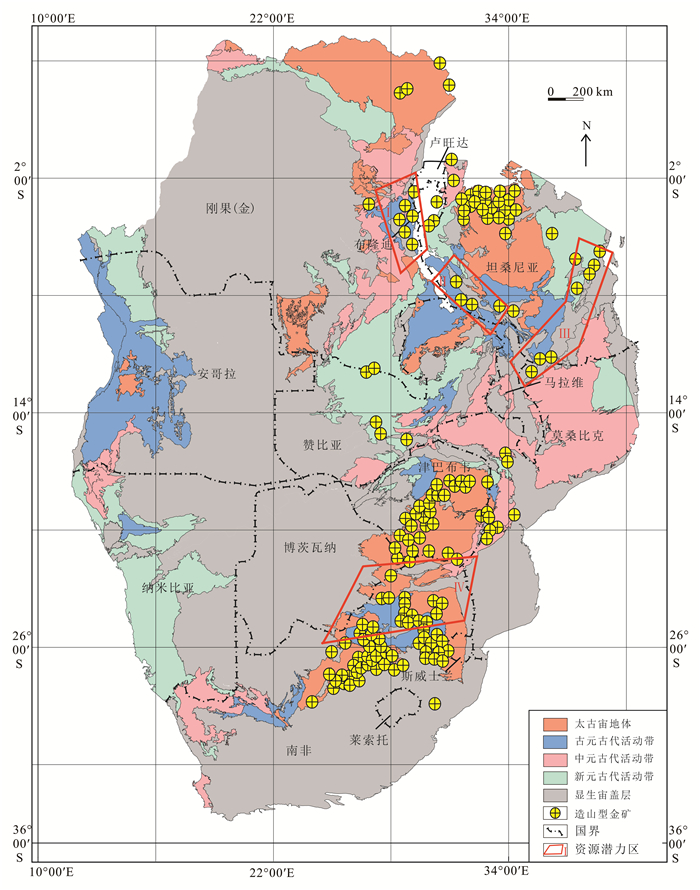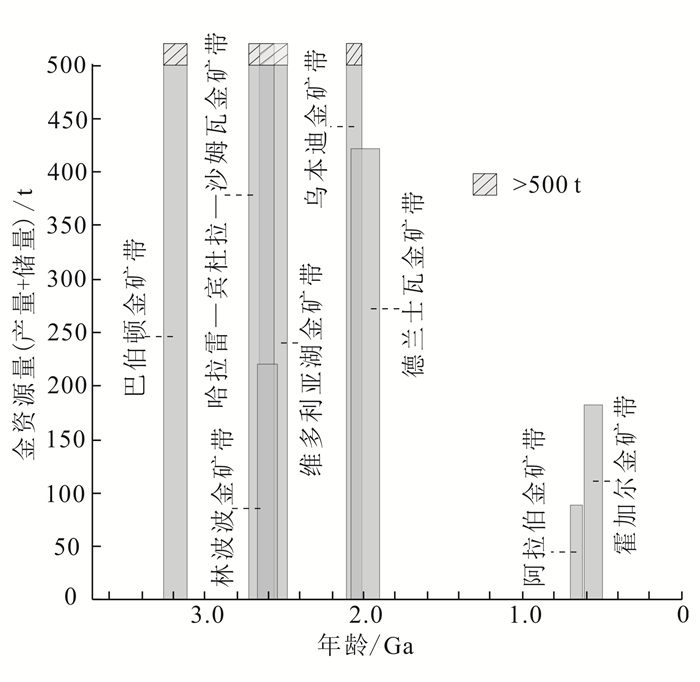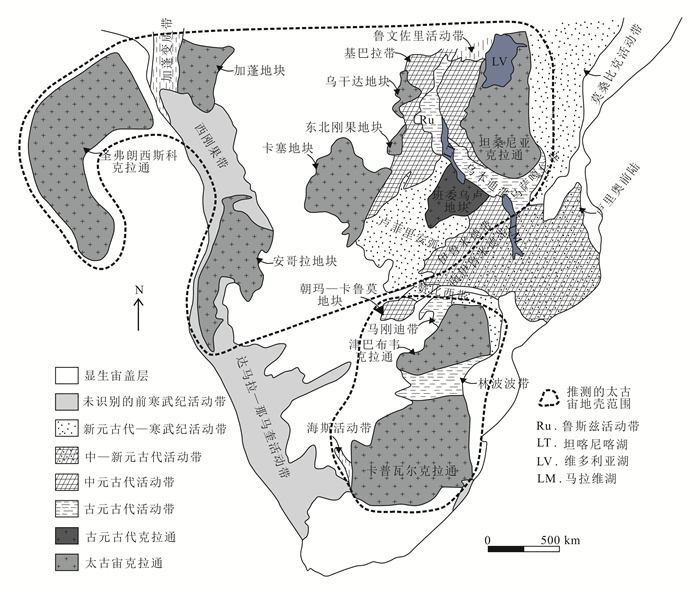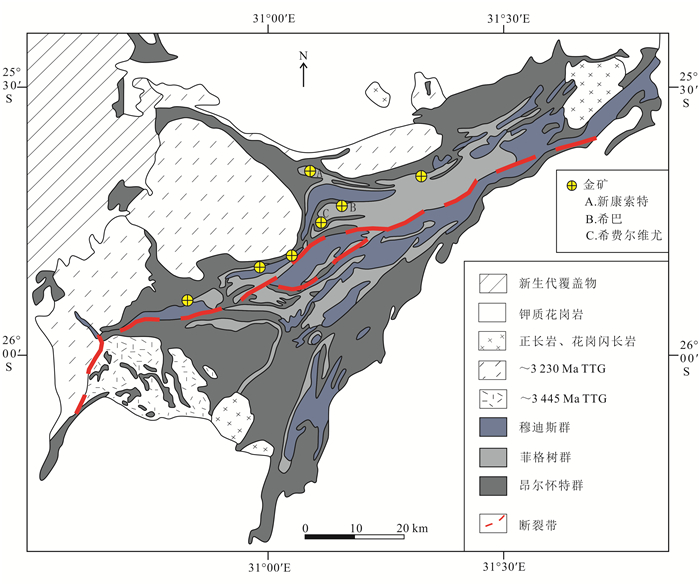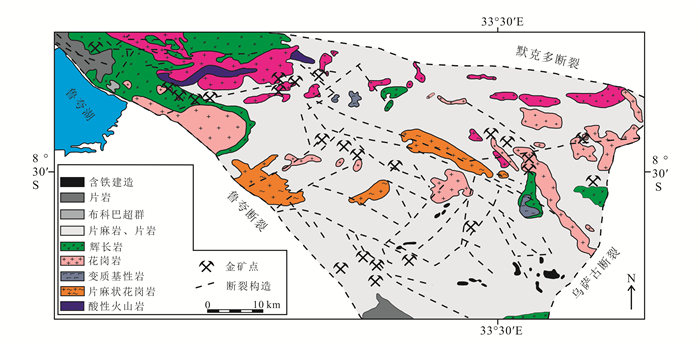0 引言
黄金由于兼具金融、货币和商品属性,有别于其他金属而成为一种非常重要的战略矿种,对维护国家经济和金融安全,保障国民财富的安全稳定增长具有不可替代的作用。近年来,中国以每年近10%的速度消耗黄金地质资源[1],已探明资源不足问题将成为制约中国黄金产业可持续发展的主要问题。为加强境外矿产资源的开发利用,国家提出矿产资源勘查开发“走出去”和“一带一路”倡议,非洲东南部地区丰富的金矿资源必将成为中国海外矿业投资的热土。
非洲东南部地区矿产资源丰富[2-3],其中金矿类型以造山型为主。该类型金矿也是世界上最重要的金矿床类型之一,占世界47%的金储量。在全球已知的149个金储量大于100 t的超大型金矿床中,造山型占42%(63个);在全球已知的36个金储量大于500 t的金矿床中, 造山型金矿占61%(22个);在全球已知的11个金储量大于1 000 t的巨型金矿床中, 造山型金矿占55%(6个)[4-6]。该类型金矿与造山作用在时间、空间上存在紧密的关系,但其成因与岛弧、火山弧环境下形成的斑岩型及浅成低温热液型金矿床存在着明显的区别[7-9]。尽管目前对非洲东南部地区金矿类型、地质特征[10-12]、成矿时代研究较多[13-20],但缺乏统一的认识,尤其是造山型金矿定义兴起之后,人们并未对非洲东南部造山型金矿成矿环境及资源潜力做进一步系统总结分析,从而限制了该类型金矿在非洲东南部地区的勘查工作。本文结合中国地质调查局地质调查项目在该区工作的开展,对非洲东南部造山型金矿成矿地质背景及资源潜力进行分析,初步总结时空分布规律,探讨成矿潜力区,以期为地勘单位在该区进行金矿勘查提供技术支撑。
1 造山型金矿的概念与矿床地质特征在造山型金矿床这个术语被提出之前,脉状金矿床的分类最早主要依据成矿温度分为低温热液、中温热液及高温热液金矿床。不同的矿床类型对应着不同的成矿深度、矿物组合和矿石结构[21]。随着对脉状金矿床研究的深入,涌现出了众多按不同标准进行命名的金矿床类型,如按控矿因素特征命名的剪切带型金矿床[22],按围岩特征分为绿岩带金矿床、浊积岩金矿床[23]等。
随着板块构造的兴起,许多学者倾向于将矿床成因类型划分与成矿地球动力学背景结合起来,从而更好地理解矿床的形成机制与区域成矿规律。Groves等[4]提出将形成于造山环境中的金矿床命名为“造山型金矿床”。此处的“造山”并不只是局限于板块构造体制建立之后的造山作用过程,也包括在太古宙板块构造体制尚未建立时发生的地体拼接过程[24]。这也是Groves等[4]把形成于太古宙绿岩带内的金矿床也归为“造山型金矿床”的原因。在国内,陈衍景[25]将造山型金矿床等同于变质热液型金矿床。
Groves等[4, 26]提出的造山型金矿床是指在板块汇聚边缘发生增生造山作用过程中形成的金矿床,即俯冲增生型造山-成矿模式,国内学者也称之为两种造山-成矿模式,即活动大陆边缘俯冲增生过程中形成的造山型金矿和大陆碰撞过程中形成的造山型金矿[27-28]。造山型金矿床的标志性特征主要有:其形成与次绿片岩相至绿片岩相的变质作用有密切关系;空间上,矿体主要受次级逆冲脆-韧性剪切带的控制;成矿流体为低盐度(<10%)、富CO2(10%~25%)的中性至弱碱性溶液;典型围岩蚀变类型为钾化、绢云母化、碳酸盐化、硫化等;矿化类型主要为含金石英-方解石脉;成矿温度与压力变化范围较大,深可达地下25 km,浅至地表,但主要集中在5~15 km深度范围内;主要的赋金矿物为黄铁矿和毒砂;元素共生组合为Au-Ag ± As± B ± Bi ± Sb ± Te ± W;金通常为唯一的成矿元素,其沉淀与构造变形作用同步[4, 26-27, 29-31]。
2 造山型金矿时空分布规律 2.1 全球造山型金矿时空分布特征Groves等[4, 26]和Goldfarb等[5, 32]系统地总结了造山型金矿床的时空分布规律,发现全球造山型金矿床形成的峰期主要集中于3.10、2.70~2.50、2.10~1.80和0.60~0.05 Ga 4个时期。其中,太古宙造山型金矿床资源量占全球造山型金矿资源量的42.9%,且新太古代占绝对主导地位;元古宙造山型金矿床占全球造山型金矿床的20.2%,且绝大部分集中在古元古代;古生代和中—新生代造山型金矿床分别占13.8%和23.1%。空间上造山型金矿与全球性造山带的分布密切相关,包括中亚(古特提斯)造山带[6]、环太平洋造山带、特提斯—喜马拉雅造山带、乌本迪(Ubendian)造山带、泛非(Pan-Africa)造山带等产出了绝大部分的造山型金矿床。
2.2 非洲东南部造山型金矿时空分布特征非洲东南部地区造山型金矿主要集中在南非、津巴布韦和坦桑尼亚境内,刚果(金)、莫桑比克、马拉维、赞比亚、布隆迪等国也有少量分布(图 1)。
非洲东南部地区是世界上保留完整太古宙陆核的地区之一,也是世界上早前寒武纪地质记录保存最好的地区之一,目前已发现大量早前寒武纪时期形成的造山型金矿(表 1)。通过搜集前人数据对比发现,该地区造山型金矿成矿时间主要集中在3个时期(3.20~3.00、2.70~2.55、2.10~1.80 Ga)(图 2),空间上主要集中在三大克拉通内部的绿岩带及克拉通之间的造山带内(表 1)。
| 金矿带 | 构造区域 | 典型矿床 | 金产量/t | 储量/t | 花岗岩体年龄/Ma | 矿化年龄/Ma | 成矿时代 | 参考文献 |
| 巴伯顿金矿带 | 卡普瓦尔克拉通 | 希巴、新康索特、费尔维尤艾格尼丝(Agnes) | > 450 | > 500 | 3 490~3 450,3 230, 3 105 | 3 126~3 084,3 250~3 230, 3 010 | 中太古代 | [33] [13] [34] |
| 哈拉雷—宾杜拉—沙姆瓦(Harare-Bindura-Shamva)金矿带 | 津巴布韦克拉通 | 维克托(Viceroy)、沙姆瓦、宾杜拉、马佐维(Mazowe)、阿图雷(Aroturue)、雷森德(Rezende) | 480 | > 400 | 2 065, 2 680~2 580 | 2 580, 2 670~2 650, 2 650~2 600 | 新太古代 | [14] [35-36] [37] |
| 林波波金矿带 | 林波波活动造山带 | 伦科(Renco)、弗曼尼(Fumani)、科林(Klein) | 40 | 180 | 2 720~2 550, 2 400, 2 670 | 2 550~2 505,2 570, 2 670 | 新太古代 | [15] [38] [39] |
| 维多利亚湖(Lake Victoria)金矿带 | 坦桑尼亚克拉通 | 盖塔(Geita)、布里杨胡鲁(Bulyanhulu)、布赫姆巴(Buhemba)、麦考德(Macalder) | > 300 | > 500 | 2 660, 2 620, 2 580~2 570, 2 530 | 2 680~2 644,2 568~2 534 | 新太古代 | [16] [40] [41] |
| 乌本迪金矿带 | 乌本迪活动造山带 | 卢帕(Lupa)、姆潘达(Mpanda) | > 120 | > 300 | 2 025, 1 940, 1 880, 1 900~1 800 | 2 100 ~1 800, 1 950~1 880 | 古元古代 | [17] [42] [43] |
| 德兰士瓦金矿带 | 卡普瓦尔克拉通 | 塞布尔—皮格瑞姆(Sable-Pilgrim) | > 345 | > 500 | 2 100, 2 050 | 2 050 | 古元古代 | [44] [18] |
| 阿拉伯(Arab)金矿带 | 泛非造山带 | 瓦加(Wajh) | 14 | 71 | 620~615, 585~565 | 700~660, 620 | 新元古代 | [19] |
| 努比亚(Nubia)金矿带 | 泛非造山带 (非洲北部) |
顿咖什(Dungash)、哈米桑那(Hamisana)、卢克索(Luxor) | > 280 | > 300 | 602~595,650~580, 850~540 | 620~580, 590~570, 580~550 | 新元古代 | [45] [20] [46] |
| 霍加尔(Hogar)金矿带 | 泛非造山带 | 艾梅斯梅萨(Amesmessa)、提雷克(Tirek)、宾亚瑞(Bin Yauri) | 10 | 170 | 725~500,620 | 611~575, 500 | 新元古代 | [47] |
中太古代(3.20~3.00 Ga)是非洲东南部造山型金矿第一个重要成矿期。卡瓦普尔克拉通(Kaapvaal craton)内部发现现存最老的造山型金矿,主要分布在巴伯顿(Barberton)绿岩带内,该绿岩带形成年龄为3.57~3.08 Ga[32],成矿时代为3.126~3.084 Ga[33],与3.23~3.08 Ga发生的俯冲增生事件密切相关[48]。克拉通内部的默奇森(Murchison)绿岩带、彼得斯堡(Pietersburg)绿岩带、萨瑟兰(Sutherland)绿岩带等均发现了较小规模的造山型金矿,但对于这些金矿的成矿年龄目前仍有争论,认为它们的形成可能与新太古代津巴布韦克拉通和卡瓦普尔克拉通碰撞直接相关[49]。
新太古代(2.70~2.55 Ga)是全球造山型金矿集中爆发的一个时期,在世界金矿分布中占有重要地位。其在非洲东南部分布尤其明显(表 1),包括津巴布韦克拉通、坦桑尼亚克拉通、林波波(Limpopo)造山带在内的多个区域均有分布,且资源量巨大,成矿时代主要集中于2.70~2.55 Ga,与新太古代克拉通碰撞造山及坦桑尼亚克拉通增生事件密切相关[50-51]。
古元古代(2.10~1.80 Ga)是又一个造山型金矿广泛分布的时期。该时期造山型金矿的形成与潘吉亚(Pangea)超大陆及伊伯尼安(Eburnean)造山带(2.10~1.90 Ga)的存在密不可分[10]。例如位于非洲东南部的坦桑尼亚乌本迪造山带,是伊伯尼安构造事件在西北方向的响应,已发现包括卢帕和姆潘达在内的多个造山型金矿,成矿时代多集中于2.10~2.00 Ga[43]。而伴随古元古代构造运动,稳定克拉通内部盆地的地层进一步变形变质,大量金矿也随之形成,卡普瓦尔克拉通内部德兰士瓦(Transvaal)盆地内大量的造山型金矿就是最好的佐证[50]。
3 非洲东南部构造格架及造山型金矿成矿环境通常巨型金矿床的形成,需要一个与之相匹配的大规模地球动力过程来提供足够的流体、金、能量等[32]。比如与造山型金矿床形成密切相关的造山作用,其形成往往会伴随着地壳加厚过程,从而增加地温梯度,进而增强变质脱流体活动,甚至诱发岩浆活动,包括造山后下地壳拆沉、俯冲板片断离、洋脊俯冲、地幔柱活动等,这些活动都可以使高温地幔直接和地壳接触,使得地壳中强大热流引发大规模流体成矿事件[5]。在构造-热事件中,强大而集中的热流驱动地壳流体活动,流体萃取相应岩石中矿化剂硫及金成矿元素,并在合适的位置沉淀成矿[32]。可以说,造山型金矿床是造山作用的成矿响应,记录了与造山作用相关的重大地质过程。在非洲东南部地区,稳定地块之间的碰撞造山带内形成的多级脆-韧性变形带及与碰撞不同阶段相关的花岗质侵入体,是非洲东南部最为重要的金成矿环境。
非洲大陆现存的主要造山事件最早可以追溯到38 Ga前,这些事件包括克拉通的形成、生长及裂解整个循环过程,并与全球性的板块构造事件相吻合。目前非洲已知的主要造山事件见表 2。
| 造山事件 | 时代/Ga | 主要表现 |
| 古太古代造山活动 | 3.55~3.15 | 太古宙早期陆核卡普瓦尔克拉通、托克维(Tokwe)陆块形成 |
| 中太古代造山活动 | 3.15~2.75 | 卡普瓦尔克拉通、津巴布韦克拉通、刚果克拉通、坦桑尼亚克拉通增生形成 |
| 新太古代造山活动 | 2.75~2.55 | 卡普瓦尔克拉通、津巴布韦克拉通、刚果克拉通、坦桑尼亚克拉通趋于稳定;卡普瓦尔克拉通与津巴布韦克拉通拼合成南非克拉通 |
| 伊伯尼安造山活动 | 2.20~1.80 | 西非克拉通沿活动边缘生长;刚果克拉通与坦桑尼亚克拉通拼合成中非克拉通;在中非克拉通及南非克拉通西部边缘形成被动大陆边缘并发生大量造山活动 |
| 基巴拉造山活动 | 1.40~0.85 | 中非克拉通与南非克拉通拼合并成为罗迪尼亚超大陆的一部分 |
| 泛非造山活动 | 0.85~0.50 | 克拉通碎片拼合成冈瓦纳超大陆,非洲处于其中心 |
| 何塞尼安(Hercynian)造山活动 | 0.45~0.25 | 非洲板块西北部及南部发生碰撞、裂解等构造活动 |
| 阿尔卑斯造山活动 | 0.12~ | 非洲板块向欧亚大陆俯冲形成阿尔卑斯山脉 |
| 注:数据引自文献[10-12]。 | ||
非洲东南部地区主要由稳定陆块和造山带两类大地构造单元组成[52-53],详见图 3。稳定陆块主要包括:卡普瓦尔克拉通,形成于3.70~2.70 Ga, 主要由太古宙的花岗岩-绿岩带组成,根据构造组成及形成时代,其内部可划分为多个次级陆块,主要包括金伯利(Kimberly)地块(3.00~2.80 Ga)、彼得斯堡(Pietersburg)地块(3.00~2.80 Ga)、兰德(Witwatersrand)地块(3.60~3.10Ga)、斯威士兰(Swaziland)地块(3.60~3.10 Ga)[54-55];津巴布韦克拉通,位于卡普瓦尔克拉通的北部,形成于3.60~2.50 Ga,分别在3.50、3.30、2.90、2.60 Ga几个时期经历了增生变大,最终形成稳定克拉通,其岩石组成主要为花岗岩和绿岩带[56-57];坦桑尼亚克拉通,形成于2.85~2.62 Ga,主要有3个增长时期,分别是2.85~2.80、2.77~2.73、2.70~2.62 Ga,其中2.70~2.62 Ga为其主增长期[58-60],克拉通内部主要由花岗闪长岩、花岗岩、片麻岩、混合岩及一系列的高级变质岩组成的多多马(Dodoma)超群和由大量的花岗岩-绿岩带组成的泥安兹(Nyanzian)超群构成[61];班委乌卢(Bangweulu)地块,位于坦桑尼亚克拉通西南部,乌本迪造山带将其与坦桑尼亚克拉通分隔开,形成于1.90~1.80 Ga,主要由花岗岩、花岗片麻岩组成[62]。
活动造山带主要包括:津巴布韦克拉通与卡瓦普尔克拉通之间的林波波造山带,其由大量高级变质岩组成,形成于2.00~3.00 Ga,是津巴布韦克拉通与卡瓦普尔克拉通多次碰撞的直接结果[63],内部发育大量花岗岩岩浆活动,绿岩带也十分发育[64],按岩性不同分为以麻粒岩相(2.70 Ga)为主的中央区、以花岗岩和绿岩带为主的南部区域(卡普瓦尔克拉通边缘)和北部区域(津巴布韦克拉通边缘)3个不同区域。坦桑尼亚克拉通四周被多个元古宙活动造山带所包围,克拉通西南部和东南部分别为古元古代乌本迪造山带和乌萨嘎仁(Usagaran)造山带,西北部和北部分别为中元古代基巴拉(Kibaran)造山带、鲁文佐里(Rwenzori)造山带,东部则为新元古代(1.20~0.45 Ga)莫桑比克造山带。乌本迪造山带主要是由麻粒岩、角闪岩相片麻岩及变质碎屑岩组成,变质变形事件主要有2.10~2.00、1.86 Ga 2期次[42];乌萨嘎仁造山带主要由花岗岩和正片麻岩组成,其变质变形期略早于乌本迪造山带[42];基巴拉造山带主要由角闪岩等变质岩组成;鲁文佐里造山带则主要为变质碎屑岩及花岗岩(1.85 Ga)[42];莫桑比克造山带属于典型的喜马拉雅式大陆碰撞造山带[65],主要由受后期泛非造山运动影响而发生变质变形的片麻岩组成。
4 典型矿床特征分析目前研究认为,造山型金矿是威尔逊旋回从俯冲增生到碰撞造山不同构造演化时期不同地壳深度(中/下地壳为主)变质变形地体中的脉型/蚀变岩型金矿床[66],成矿多与造山中晚期的绿片岩相变质变形及花岗岩类岩浆侵入过程关系密切,常在地壳不同深度出现彼此关联的多种矿化样式,形成造山金矿床系列。在非洲东南部,自古元古代开始,多个克拉通多期次碰撞形成大量活动造山带,并在其地壳内形成多级脆-韧性变形带及碰撞不同阶段相关的花岗质侵入体,形成了非洲东南部最为重要的金成矿环境。目前已发现了大量与之相关金矿床,见表 1。
4.1 南非巴伯顿金矿带位于南非卡普瓦尔克拉通的巴伯顿绿岩带内部已发现大量造山型金矿床,尤其是绿岩带西北部最为集中,形成时代多在3.00 Ga之前,是世界上已知的形成时代最早的造山型金矿。该地区自1883年见矿至今已发现超过300个金矿床(点),开采了345 t以上的黄金,品位最高可达13 g/t[32],主要由希巴(123.7 t)、新康索特(63.4 t)、费尔维尤(63.4 t)3个矿区组成[18]。
巴伯顿绿岩带中金矿主要赋存在斯威士兰超群中,该超群自下而上又分为3个群,即昂尔怀特(Onverwaeht)群、菲格树(The Fig Tree)群和穆迪斯(Moodies)群(图 4),整个地层厚度大于2 km。其中,昂尔怀特群(3.55~3.30 Ga)最为重要,厚度大于15 km,主要由镁铁质—超镁铁质火山岩和少量长英质火山岩组成,可分为6个组:下部3个组统称为下超镁铁质单元,其特征是广泛分布科马提岩和拉斑玄武岩, 并夹有少量铁建造,火山岩序列厚达8~9 km;上部3个组是钙碱性火山岩系,主要为镁铁质火山岩到长英质火山岩,并夹有隧石和含铁建造,科马提岩很少,厚度7~8 km。菲格树群(3.26~3.21 Ga)主要是泥质单元,厚度约2 km,主要由页岩、硬砂岩、隧石、含铁建造和粗粒陆源碎屑岩组成,并见有少量集块岩、凝灰岩和英安质熔岩,不整合产在昂尔怀特群上。穆迪斯群(3.21~3.16 Ga)是砂质沉积岩,厚度3~5 km,主要岩性为砾岩、石英岩、硬砂岩、砂岩,次要岩性主要为含铁建造、隧石和镁铁质火山岩,该群呈假整合到不整合产在菲格树群上[67-68]。
巴伯顿绿岩带内的金矿床都具有相似的结构、构造特点,金主要赋存在石英-碳酸盐脉中,并与大量的硫化物共生,矿石矿物主要为毒砂和黄铁矿[69-70]。容矿围岩变化较大,从最上面的昂尔怀特群的变质基性、超基性岩石到菲格树群的变质砂岩、页岩均有分布,绿片岩相的蚀变带从矿体向远端矿物组合变化明显:绢云母-石英-硫化物±碳酸盐±铬云母、铬云母-石英-碳酸盐±硫化物、石英-碳酸盐、滑石-碳酸盐[69-70]。流体包裹体研究显示其为低盐(w(NaCl)=5%~6%)、富H2O-CO2流体,均一温度达290~310 ℃[70]。矿床分布在空间上与逆冲断层密切相关,也因此被称为造山型金矿[70-71]。费尔维尤矿区早于剪切带生成的斑岩脉的锆石U-Pb年龄(3 126±21 Ma),与金矿化密切相关的热液活动年龄为(3 084±18)Ma[33]。但也有一些较为年轻的年龄数据在其他矿区被证实,包括希巴矿区锆石Pb-Pb同位素年龄3.01 Ga[13],新康索特矿区锆石U-Pb年龄3.04~3.03 Ga[34],这也说明巴伯顿绿岩带内存在多个矿化事件,金矿化期持续了数十个百万年,但基本与卡普瓦尔克拉通与津巴布韦克拉通碰撞造山的时间相一致。
4.2 坦桑尼亚卢帕金矿集区卢帕金矿集区位于坦桑尼亚西南部姆贝亚省(Mbeya)及伊林加省(Iringa),占据一个西起鲁夸(Rukwa)、东至乌萨古(Usangu)、北到默克多(Mkondo)断裂的三角形区域(图 5),面积3 000 km2左右,内部也可划分为多个次级成矿区[73]。大地构造位于乌本迪活动带的东南缘,该金矿被认为是地球早期俯冲造山期间金矿形成的典型事例[74]。
金矿集区主要受北西—南东走向的复背斜控制,区内发育多期低级褶皱,剪切作用也十分发育,并影响了几乎所有岩石单元。区内主要岩石地层组成自下而上为:底部古元古界乌本迪超群,由一套沉积和火成成因的高级变质岩(麻粒岩相)组成;中部中元古界基巴拉超群的泥质板岩、千枚岩、绢云母片岩等浅变质岩;上部新元古界布科巴(Bukoba)超群的砂岩、硅质岩、页岩等不整合覆盖,零星分布于矿区北西部[44, 75]。区内岩浆岩十分发育,片理化的太古宙花岗岩侵入体(2.76~2.72 Ga)被古元古代花岗岩侵入体以及闪长岩-辉长岩侵入体(1.96~1.88 Ga)所切割,而古元古代的岩浆活动对金矿的形成具有重要意义[74]。
卢帕金矿集区内存在多个金矿体,但单一矿体储量较小,品位较高,最高可达15 g/t,找矿潜力巨大[72]。区内金矿化类型主要有3种:石英脉型、磁铁石英岩型、砂矿型,其中与剪切带(糜棱岩化)伴生的石英脉型最为普遍[76]。含矿石英脉主要赋存于剪切作用形成的破劈理中[77-79],矿石矿物主要有自然金、黄铜矿、辉钼矿、方铅矿、闪锌矿、黄铁矿等,呈浸染状、脉状、细脉浸染状、团块状产出。脉石矿物由石英、绿泥石、电气石、绢云母、碳酸盐岩等组成。矿脉周围发育多期次热液蚀变,已发现的主要蚀变类型有黄铁矿化、绢云母化、硅化等,其中硅化、黄铁矿化对寻找金矿具有重要指示意义[71]。
已获得的辉钼矿Re-Os同位素年龄数据显示,卢帕金矿集区在19.5~18.8 Ga主要存在3期(1.95, 1.94, 1.88 Ga)与成矿密切相关的热液蚀变事件。其中,18.8 Ga的热液蚀变作用导致大量硫化物形成,对该区金矿的进一步富集成矿具有重要作用,而该时期恰好与乌本迪造山旋回期中的榴辉岩相变质事件相吻合,说明金矿的形成与造山活动密切相关,属典型的造山型金矿[26, 52]。
4.3 津巴布韦维克托金矿维克托金矿位于津巴布韦首都哈拉雷以东30 km的恩特普莱斯(Enterprise)绿岩带上[80],呈NW向展布。该绿岩带属于哈拉雷—宾杜拉—沙姆瓦绿岩带的一部分(图 6),已产出超过80 t的金,品位8.5 g/t左右,金矿化主要赋存在新太古代上布拉瓦约群艾克特若斯(Arcturus)组的变质基性岩中[81]。艾克特若斯组主要由大量的铁镁质变质火山岩组成,包括变玄武岩以及变辉长岩,另外还有少量的片岩、长英质变火山岩、变沉积岩。变质基性岩以角闪岩相为主,并见有少量的绿片岩相。矿区构造主要受NS向的主断裂和NNE向的二级断裂控制,断裂带内发育多条石英脉,金及硫化物赋存其中,也见有少量的后期方解石脉发育[81]。
金的赋存形式主要有2种:一种是与含铋矿物共生,另一种是金以类质同象的形式赋存在毒砂、磁黄铁矿中。与金矿相伴生的矿物主要是毒砂,其次是磁黄铁矿,另外还有少量的黄铜矿、闪锌矿、方铅矿、白钨矿以及一些含铋的硫化物等。毒砂以半自形、他形为主,多被石英包裹或切割,极少出现在碳酸盐脉中。围岩蚀变主要发生在矿化带附近,主要有钾化、碳酸盐化。流体包裹体分析显示,其为富CO2-CH4-N2,高盐,均一温度为310~380 ℃,压力225~230 MPa[37]。关于该金矿的成矿时代目前没有明确说明,但该金矿所属的哈拉雷—宾杜拉—沙姆瓦绿岩带形成时间为2.67~2.60 Ga[80],与林波波带的形成时代基本一致。因此,推测该金矿属于与林波波造山事件密切相关的造山型金矿。
5 资源潜力分析截至目前,非洲东南部地区已发现大量大型、超大型造山型金矿,但其仍具有很好的找矿潜力。通过对数据资料的整理分析,对非洲东南部地区划分了4个造山型金矿找矿潜力区(图 1),位置主要集中在克拉通之间的碰撞造山带内。
基巴拉金矿带潜力区(Ⅰ)位于基巴拉造山带内,该造山带是由罗迪尼亚超大陆形成演化中坦桑尼亚克拉通与刚果克拉通碰撞所致,大规模造山活动主要集中在1.40~0.90 Ga,目前仅在布隆迪和卢旺达等地发现了中小型造山型金矿床,年龄多在1.00~0.90 Ga[82-83]。如此大规模的造山活动十分有利于大型、超大型造山型金矿床的形成。因此,笔者认为基巴拉造山带内造山型金矿找矿潜力巨大。
乌本迪金矿带潜力区(Ⅱ)位于乌本迪造山带内,该金矿带已发现卢帕金矿集区。但矿集区内以大量散布的中小型造山型金矿为主,大型、超大型造山型金矿未有突破,因此该地区也具有较大资源潜力。
泛非金矿带潜力区(Ⅲ)位于泛非造山带内,该造山带内已发现有大量的大型、超大型造山型金矿,形成了一个巨大的“冈瓦纳造山型金矿带”。但目前已发现的大型金矿主要集中在该造山带西部的利比亚、阿尔及利亚和北部的苏丹、沙特阿拉伯等地,而其南端的非洲东南部地区目前还未找到相关的较大规模造山型金矿床,仅在马拉维和赞比亚东部发现有部分小型金矿床[19, 84]。因此,笔者认为该地区也具有寻找大型、超大型造山型金矿的优越条件。
林波波金矿带潜力区(Ⅳ)位于林波波造山带内,其内部的大型造山型金矿均存在多期次的矿化事件,且目前勘探程度仍有限,其外围及深部仍具有较大潜力。
6 结论1) 稳定地块之间的碰撞造山带内形成的多级脆-韧性变形带及与碰撞不同阶段相关的花岗质侵入体,构成了非洲东南部地区最为重要的造山型金矿成矿环境。
2) 非洲东南部造山型金矿的时空分布特征与超大陆的拼合、裂解事件相耦合,时间上主要集中在3.20~3.00、2.70~2.55和2.10~1.80 Ga 3个时期;空间上主要分布在卡普瓦尔克拉通、津巴布韦克拉通、坦桑尼亚克拉通内部的绿岩带以及林波波造山带、乌本迪造山带、基巴拉造山带、泛非造山带中。
3) 非洲东南部地区造山型金矿成矿地质条件优越,乌本迪金矿带、基巴拉金矿带、泛非金矿带以及林波波金矿带总体找矿勘查程度较低,资源潜力巨大。
致谢: 中国地质调查局天津地质调查中心付超高级工程师、党智财工程师、古阿雷工程师在成文过程中提供了大量的帮助,在此表示衷心的感谢!| [1] |
刘山恩.中国黄金年鉴2012[R].北京: 中国黄金协会, 2013: 1-87. Liu Shan'en. China Golden Yearbook of 2012[R]. Beijing: China Gold Association, 2013: 1-87. |
| [2] |
任军平, 王杰, 刘晓阳, 等. 非洲中南部铜多金属矿床研究现状及找矿潜力分析[J]. 吉林大学学报(地球科学版), 2017, 47(4): 1083-1103. Ren Junping, Wang Jie, Liu Xiaoyang, et al. Research Status and Prospecting Potential of Copper Polymetallic Deposits in Central-South Africa[J]. Journal of Jilin University (Earth Science Edition), 2017, 47(4): 1083-1103. |
| [3] |
唐文龙, 孙宏伟, 刘晓阳, 等. 中南部非洲镍矿成矿规律及资源潜力分析[J]. 吉林大学学报(地球科学版), 2018, 48(1): 1-17. Tang Wenlong, Sun Hongwei, Liu Xiaoyang, et al. Metallogeny and Resource Potential of Nickel Deposits in the Mid-Southern Africa[J]. Journal of Jilin University (Earth Science Edition), 2018, 48(1): 1-17. |
| [4] |
Groves D I, Goldfarb R J, Gebre-Mariam H, et al. Orogenic Gold Deposits-a Proposed Classification in the Context of Their Crustal Distribution and Relationship to Other Gold Deposit Type[J]. Ore Geology Reviews, 1998, 13(1/2/3/4/5): 7-27. |
| [5] |
Goldfarb R J, Baker T, Dube B, et al. Distribution, Character and Genesis of Gold Deposits in Metamorphic Terranes[C]//Hedenquist J W, Thompson J F H, Goldfarb R G. Economic Geology 100th Anniversary Volume. Littleton: Society of Economic Geologists, 2005: 407-450.
|
| [6] |
薛春纪, 赵晓波, 张国震, 等. 西天山金铜多金属重要成矿类型、成矿环境及找矿潜力[J]. 中国地质, 2015, 42(3): 381-410. Xue Chunji, Zhao Xiaobo, Zhang Guozhen, et al. Metallogenic Environments, Ore-Forming Types and Prospecting Potential of Au-Cu-Zn-Pb Resources in Western Tianshan Mountains[J]. Geology in China, 2015, 42(3): 381-410. DOI:10.3969/j.issn.1000-3657.2015.03.002 |
| [7] |
Sillitoe R H, Hedenquist J W. Linkages Between Vol-canotectonic Settings, Ore-Fluid Compositions, and Epithermal Precious Metal Deposits[J]. Society of Economic Geologists Specical Publication, 2003, 10: 315-343. |
| [8] |
Sillitoe R H. Porphyry Copper Systems[J]. Economic Geology, 2010, 105(1): 3-41. DOI:10.2113/gsecongeo.105.1.3 |
| [9] |
Hedenquist J W, Arribas A, Gonzalez-Urien E. Exp-loration for Epithermal Gold Deposits[J]. Reviews in Economic Geology, 2000, 13(2): 245-277. |
| [10] |
Cooper M R. Tectonic Cycles in Southern Africa[J]. Earth Science Reviews, 1990, 28(4): 321-364. DOI:10.1016/0012-8252(90)90053-X |
| [11] |
Youssof M, Thybo H, Artemieva I M, et al. Moho Depth and Crustal Composition in Southern Africa[J]. Tectonophysics, 2013, 609: 267-287. DOI:10.1016/j.tecto.2013.09.001 |
| [12] |
Tugume F, Nyblade A, Julià J, et al. Precambrian Crustal Structure in Africa and Arabia:Evidence Lacking for Secular Variation[J]. Tectonophysics, 2013, 609: 250-266. DOI:10.1016/j.tecto.2013.04.027 |
| [13] |
Dirks P H G M, Charlesworth E G, Munyai M R, et al. Stress Analysis, Postorogenic Extension and 3.01 Ga Gold Mineralisation in the Barberton Greenstone Belt, South Africa[J]. Precambrian Research, 2013, 226: 157-184. DOI:10.1016/j.precamres.2012.12.007 |
| [14] |
Markwitz V, Maier W D, González-Álvarez I, et al. Magmatic Nickel Sulfide Mineralization in Zimbabwe:Review of Deposits and Development of Exploration Criteria for Prospectivity Analysis[J]. Ore Geology Reviews, 2010, 38: 139-155. DOI:10.1016/j.oregeorev.2010.07.004 |
| [15] |
Smit C A, Van Reenen D D, Roering C. Role of Fluids in the Exhumation of the Southern Marginal Zone of the Limpopo Complex, South Africa[J]. Precambrian Research, 2014, 253: 81-95. DOI:10.1016/j.precamres.2014.07.002 |
| [16] |
Emel J, Plisinski J, Rogan J. Monitoring Geomorphic and Hydrologic Change at Mine Sites Using Satellite Imagery:The Geita Gold Mine in Tanzania[J]. Applied Geography, 2014, 54: 243-249. DOI:10.1016/j.apgeog.2014.07.009 |
| [17] |
Lawley C J M, Selby D, Condon D, et al. Palaeo-proterozoic Orogenic Gold Style Mineralization at the Southwestern Archaean Tanzanian Cratonic Margin, Lupa Goldfield, SW Tanzania:Implications from U-Pb Titanite Geochronology[J]. Gondwana Research, 2014, 26(3/4): 1141-1158. |
| [18] |
Dirks P H G M, Charlesworth E G, Munyai M R. Cratonic Extension and Archaean Gold Mineralisation in the Sheba-Fairview Mine, Barberton Greenstone Belt, South Africa[J]. South African Journal of Geology, 2009, 112(3/4): 291-316. |
| [19] |
LeAnderson P J, Yoldash M, Johnson P R, et al. Structure, Vein Paragenesis, and Alteration in the Al Wajh Gold District, Saudi Arabia[J]. Economic Geology, 1995, 90(8): 2262-2273. DOI:10.2113/gsecongeo.90.8.2262 |
| [20] |
Botros N S. The Role of the Granite Emplacement and Structural Setting on the Genesis of Gold Mineralization in Egypt[J]. Ore Geology Reviews, 2015, 70: 173-187. DOI:10.1016/j.oregeorev.2015.04.014 |
| [21] |
Lindgren W. Mineral Deposits[M]. New York and London: McGraw-Hill Book Company, 1913: 547-551.
|
| [22] |
Bonnemaison M, Marcoux E. Auriferous Minerali-zation in Some Shear Zones:A Three Stage Model of Metalogenesis[J]. Mineralium Deposita, 1990, 25(2): 96-104. |
| [23] |
Mueller A G, Groves D I. The Classification of Western Australian Greenstone-Hosted Gold Deposits According to Wallrock-Alteration Mineral Assemblages[J]. Ore Geology Reviews, 1991, 6(4): 291-331. DOI:10.1016/0169-1368(91)90008-U |
| [24] |
Hagemann S, Cassidy K F. Archean Orogenic Lode Gold Deposits[J]. Reviews in Economic Geology, 2000, 13: 9-68. |
| [25] |
陈衍景. 大陆碰撞成矿理论的创建及应用[J]. 岩石学报, 2013, 29(1): 1-17. Chen Yanjing. The Development of Continental Collision Metallogeny and Its Application[J]. Acta Petrologica Sinica, 2013, 29(1): 1-17. |
| [26] |
Groves D I, Goldfarb R J, Robert F, et al. Gold Deposits in Metamorphic Belts:Overview of Current Understanding, Outstanding Problems, Future Research, and Exploration Significance[J]. Economic Geology, 2003, 98(1): 1-29. |
| [27] |
陈衍景. 造山型矿床、成矿模式及找矿潜力[J]. 中国地质, 2006, 33(6): 1181-1196. Chen Yanjing. Orogenic-Type Deposits and Their Metallogenic Model and Exploration Potential[J]. Geology in China, 2006, 33(6): 1181-1196. DOI:10.3969/j.issn.1000-3657.2006.06.001 |
| [28] |
蒋少涌, 戴宝章, 姜耀辉, 等. 胶东和小秦岭:两类不同构造环境中的造山型金矿省[J]. 岩石学报, 2009, 25(11): 2727-2738. Jiang Shaoyong, Dai Baozhang, Jiang Yaohui, et al. Jiaodong and Xiaoqinling:Two Orogenic Gold Provinces Formed in Different Tectonic Settings[J]. Acta Petrologica Sinica, 2009, 25(11): 2727-2738. |
| [29] |
Goldfarb R J, Leach D L, Pickthorn W J, et al. Origin of Lode-Gold Deposits of the Juneau Gold Belt, Southeastern Alaska[J]. Geology, 1988, 16(5): 440-443. DOI:10.1130/0091-7613(1988)016<0440:OOLGDO>2.3.CO;2 |
| [30] |
Goldfarb R J, Snee L W, Pickthorn W J. Orogenesis, High-T Thermal Events, and Gold Vein Formation Within Metamorphic Rocks of the Alaskan Cordillera[J]. Mineralogical Magazine, 1993, 57(3): 375-394. |
| [31] |
邱正杰, 范宏瑞, 丛培章, 等. 造山型金矿床成矿过程研究进展[J]. 矿床地质, 2015, 34(1): 21-28. Qiu Zhengjie, Fan Hongrui, Cong Peizhang, et al. Recent Progress in the Study of Ore-Forming Processes of Orogenic Gold Deposits[J]. Mineral Deposits, 2015, 34(1): 21-28. |
| [32] |
Goldfarb R J, Groves D, Gardoll S. Orogenic Gold and Geologic Time:A Global Synthesis[J]. Ore Geology Reviews, 2001, 18(1): 1-75. |
| [33] |
De Ronde C E J, Kamo S L, Davis D W, et al. Field, Geochemical and U-Pb Isotopic Constraints from Hypabyssal Felsic Intrusion Within the Barberton Greenstone Belt, South Africa:Implications for Tectonics and the Timing of Gold Mineralization[J]. Precambrian Research, 1991, 49(3/4): 261-280. |
| [34] |
Dziggel A, Poujol M, Otto A, et al. New U-Pb and Ar40/Ar39 Ages from the Northern Margin of the Barberton Greenstone Belt, South Africa:Implications for the Formation of Mesoarchaean Gold Deposits[J]. Precambrian Research, 2010, 179(1): 206-220. |
| [35] |
Mc Keagney C J, Boulter C A, Jolly R J H, et al. 3-D Mohr Circle Analysis of Vein Opening, Indarama Lode-Gold Deposit, Zimbabwe:Implications for Exploration[J]. Journal of Structural Geology, 2004, 26(6): 1275-1291. |
| [36] |
Buchholz P, Oberthur T. Multistage Au-As-Sb Mineralization and Crustal-Scale Fluid Evolution in the Kwekwe District, Midlands Greenstone Belt, Zimbabwe:A Combined Geochemical, Mineralogical, Stable Isotope, and Fluid Inclusion Study[J]. Economic Geology, 2007, 102(3): 347-378. DOI:10.2113/gsecongeo.102.3.347 |
| [37] |
Oberthur T, Weiser T W. Gold-Bismuth-Telluride-Sulphide Assemblages at the Viceroy Mine, Harare-Bindura-Shamva Greenstone Belt, Zimbabwe Mineralogical[J]. Magazine, 2000, 72(4): 953-970. |
| [38] |
Kolb J, Kisters A M F, Hoernes S, et al. The Origin of Fluids and Nature of Fluid-Rock Interaction in Midcrustal Auriferous Mylonites of the Renco Mine, Southern Zimbabwe[J]. Mineralium Deposita, 2000, 35(2/3): 109-125. |
| [39] |
Van Reenen D D, Pretorius A I, Roering C. Char-acterization of Fluids Associated with Gold Mineralization and with Regional High Temperature Retrogression of Granulites in the Limpopo Belt, South Africa[J]. Geochimica et Cosmochimica Acta, 1994, 58(3): 1147-1159. DOI:10.1016/0016-7037(94)90578-9 |
| [40] |
Sanislav I V, Wormald R J, Dirks P H G M, et al. Zircon U-Pb Ages and Lu-Hf Isotope Systematics from Late-Tectonic Granites, Geita Greenstone Belt:Implications for Crustal Growth of the Tanzania Craton[J]. Precambrian Research, 2014, 242: 187-204. DOI:10.1016/j.precamres.2013.12.026 |
| [41] |
Pinna P, Cocherie A, Thieblemont D, et al. The Archean Evolution of the Tanzanian Craton (2.03-2.53 Ga)[J]. Journal of African Earth Sciences, 1999, 28(4): 62-63. |
| [42] |
Lenoir J L, Liegeois J P, Theunissen K, et al. The Paleoproterozoic Ubendian Shear Belt in Tanzania:Geochronology and Structure[J]. Journal of African Earth Sciences, 1994, 19(3): 169-184. DOI:10.1016/0899-5362(94)90059-0 |
| [43] |
Kuehn S, Ogola J, Sango P. Regional Setting and Nature of Gold Mineralization in Tanzania and Southwest Kenya[J]. Precambrian Research, 1990, 46(1): 71-82. |
| [44] |
Boer R H, Meyer F M, Robb L J, et al. Meso-thermal-Type Mineralization in the Sabie-Pilgrim's Rest Gold Field, South Africa[J]. Economic Geology, 1995, 90(4): 860-876. DOI:10.2113/gsecongeo.90.4.860 |
| [45] |
Zoheir B, Weihed P. Greenstone-Hosted Lode-Gold Mineralization at Dungash Mine, Eastern Desert, Egypt[J]. Journal of African Earth Sciences, 2014, 99: 165-187. DOI:10.1016/j.jafrearsci.2013.06.002 |
| [46] |
Worku H. Structural Control and Metamorphic Se-tting of Shear Zone-Related Au Vein Mineralization of the Adola Belt (Southern Ethiopia) and Its Tectono Genetic Development[J]. Journal of African Earth Sciences, 1996, 23(3): 383-409. DOI:10.1016/S0899-5362(97)00009-2 |
| [47] |
Garba I. Tourmalinization Related to Late Protero-zoic-Early Paleozoic Lode Gold Mineralization in the Bin Yauri Area, Nigeria[J]. Mineralium Deposita, 1996, 31(3): 201-209. DOI:10.1007/BF00204027 |
| [48] |
De Ronde C E J, De Wit M J. Tectonic History of the Barberton Greenstone Belt, South Africa:490 Million Years of Archean Crustal Evolution[J]. Tectonics, 1994, 13(4): 983-1005. DOI:10.1029/94TC00353 |
| [49] |
Foster R P, Piper D P. Archaean Lode Gold Deposits in Africa-Crustal Setting, Metallogenesis and Cratonization[J]. Ore Geology Reviews, 1993, 8(3/4): 303-347. |
| [50] |
Darbyshire D P F, Pitfield P E J, Campbell S D G. Late Archean and Early Proterozoic Gold-Tungsten Mineralization in the Zimbabwe Archean Craton Rb-Sr and Sm-Nd Isotope Constraints[J]. Geology, 1996, 24(1): 19-22. DOI:10.1130/0091-7613(1996)024<0019:LAAEPG>2.3.CO;2 |
| [51] |
Vinyu M L, Frei R, Jelsma H A. Timing Between Granitoid Emplacement and Associated Gold Mineralization-Examples from the Ca.2.7 Ga Harare-Shamva Greenstone Belt, Northern Zimbabwe[J]. Canadian Journal of Earth Sciences, 1996, 33(7): 981-992. DOI:10.1139/e96-074 |
| [52] |
Haest M, Muchez P. Stratiform and Vein-Type Deposits in the Pan-African Orogeny in Central and Southern Africa:Evidence for Multiphase Mineralization[J]. Geologica Belgica, 2011, 14(1/2): 23-44. |
| [53] |
Potrel A, Peucat J J, Fanning C M. Archean Crustal Evolution of the West African Craton:Example of the Amsaga Area, U-Pb and Sm-Nd Evidence for Crustal Growth and Recycling[J]. Precambrian Research, 1998, 90(3): 107-117. |
| [54] |
Eglington B M, Armstrong R A. The Kaapvaal Craton and Adjacent Orogens, Southern Africa:A Geochronological Database and Overview of the Geological Development of the Craton[J]. South African Journal of Geology, 2004, 107(1/2): 13-32. |
| [55] |
Wit M J D, Ronde C E J D, Tredoux M, et al. Formation of an Archean Continent[J]. Nature, 1992, 357: 553-562. DOI:10.1038/357553a0 |
| [56] |
Wilson J F. A Craton and Its Cracks:Some of the Behaviour of the Zimbabwe Block from the Late Archaean to the Mesozoic in Response to Horizontal Movements, and the Significance of Some of Its Mafic Dyke Fracture Patterns[J]. Journal of African Earth Sciences (and the Middle East), 1990, 10(3): 483-501. DOI:10.1016/0899-5362(90)90101-J |
| [57] |
Dirks P H G M, Jelsma H A. Crust-Mantle De-coupling and the Growth of the Archean Zimbabwe Craton[J]. Journal of African Earth Sciences, 2002, 34(3/4): 157-166. |
| [58] |
Gabert G. Lithostratigraphic and Tectonic Setting of Gold Mineralization in the Archeancratons of Tanzania and Uganda[J]. Precambrian Research, 1990, 46(1/2): 59-69. |
| [59] |
Pinna P, Cocherie A, Thieblemont D, et al. The Kisii Group of Western Kenya:An End-Archaean (2.53 Ga) Late Orogenic Volcano Sedimentary Sequence[J]. Journal of African Earth Sciences, 2000, 30(1): 79-97. DOI:10.1016/S0899-5362(00)00009-9 |
| [60] |
Sanislav I V, Wormald R J, Dirks P, et al. Zircon U-Pb Ages and Lu-Hf Isotope Systematics from Late-Tectonic Granites, Geita Greenstone Belt Implications for Crustal Growth of the Tanzania Craton[J]. Precambrian Research, 2014, 242: 187-204. DOI:10.1016/j.precamres.2013.12.026 |
| [61] |
Manya S, Maboko M A H. Dating Basaltic Volcanism in the Neoarchaean Sukumaland Greenstone Belt of the Tanzania Craton Using the Sm-Nd Method:Implications for the Geological Evolution of the Tanzania Craton[J]. Precambrian Research, 2003, 121(1): 35-45. |
| [62] |
Waele B D, Liégeois J P, Nemchin A A, et al. Isotopic and Geochemical Evidence of Proterozoic Episodic Crustal Reworking Within the Irumide Belt of South-Central Africa, the Southern Metacratonic Boundary of an Archaean Bangweulu Craton[J]. Precambrian Research, 2006, 148(3): 225-256. |
| [63] |
McCourt S, Van Reenen D D. Structural Geology and Tectonic Setting of the Sutherland Greenstone Belt, Kaapvaal Craton, South Africa[J]. Precambrian Research, 1992, 55(1/2/3/4): 93-110. |
| [64] |
Kröner A, Jaeckel P, Brandl G, et al. Single Zircon Ages for Granitoid Gneisses in the Central Zone of the Limpopo Belt, Southern Africa and Geodynamic Significance[J]. Precambrian Research, 1999, 93(4): 299-337. DOI:10.1016/S0301-9268(98)00102-8 |
| [65] |
Shackleton R M. The Final Collision Zone Between East and West Gondwana:Where Is It?[J]. Journal of African Earth Sciences, 1996, 23(3): 271-287. DOI:10.1016/S0899-5362(97)00002-X |
| [66] |
Goldfarb R J, Taylor R D, Collins G S, et al. Phanerozoic Continental Growth and Gold Metallogeny of Asia[J]. Gondwana Research, 2014, 25(1): 48-102. DOI:10.1016/j.gr.2013.03.002 |
| [67] |
Byerly G R, Kröner A, Lowe D R, et al. Prolonged Magmatism and Time Constraints for Sediment Deposition in the Early Archean Barberton Greenstone Belt:Evidence from the Upper Onverwacht and Fig Tree Groups[J]. Precambrian Research, 1996, 78(1/2/3): 125-138. |
| [68] |
Hofmann A. The Geochemistry of Sedimentary Rocks from the Fig Tree Group, Barberton Greenstone Belt:Implications for Tectonic, Hydrothermal and Surface Processes During Mid-Archaean Times[J]. Precambrian Research, 2005, 143(1/2/3/4): 23-49. |
| [69] |
Cabri L J, Chryssoulis S L, de Villiers J P R, et al. The Nature of "Invisible" Gold in Arsenopyrite[J]. The Canadian Mineralogist, 1989, 27(3): 353-362. |
| [70] |
De Ronde C E J, Spooner E T C, de Wit M J, et al. Shear Zone Related, Au Quartz Vein Deposits in the Barberton Greenstone Belt, South Africa:Field and Petrographic Characteristics, Fluid Properties, and Light Stable Isotope Geochemistry[J]. Economic Geology, 1992, 87(2): 366-402. DOI:10.2113/gsecongeo.87.2.366 |
| [71] |
Otto A, Dziggel A, Kisters A F M, et al. The New Consort Gold Mine, Barberton Greenstone Belt, South Africa:Orogenic Gold Mineralization in a Condensed Metamorphic Profile[J]. Mineralium Deposita, 2007, 42(7): 715-735. DOI:10.1007/s00126-007-0135-5 |
| [72] |
Lawley C J M, Selby D, Condon D, et al. Pala-eoproterozoic Orogenic Gold Style Mineralization at the Southwestern Archaean Tanzanian Cratonic Margin, Lupa Goldfield, SW Tanzania:Implications from U-Pb Titanite Geochronology[J]. Gondwana Research, 2014, 26(3/4): 1141-1158. |
| [73] |
Kilembe E A, Rosendahl B R. Structure and Stratigraphy of the Rukwa Rift[J]. Tectonophysics, 1992, 209(1/2/3/4): 143-158. |
| [74] |
Lawley C J M, Selby D, Condon D J, et al. Lithogeochemistry, Geochronology and Geodynamic Setting of the Lupa Terrane, Tanzania:Implications for the Extent of the Archean Tanzanian Craton[J]. Precambrian Research, 2013, 231: 174-193. DOI:10.1016/j.precamres.2013.02.012 |
| [75] |
Boniface N, Schenk V, Appel P. Paleoproterozoi-ceclogites of MORB-Typechemistry and Three Proterozoic Orogenic Cycles in the Ubendian Belt (Tanzania):Evidence from Monazite and Zircon Geochronology and Geochemistry[J]. Precambrian Research, 2012, 192: 16-33. |
| [76] |
Groves D I. The Crustal Continuum Model for Late-Archaean Lode-Golddeposits of the Yilgarn Block, Western Australia[J]. Mineralium Deposita, 1993, 28(6): 366-374. DOI:10.1007/BF02431596 |
| [77] |
Weinberg R F, Hodkiewicz P F, Groves D I. What Controls Gold Distribution in Archean Terranes[J]. Geology, 2004, 32(7): 545-548. DOI:10.1130/G20475.1 |
| [78] |
Micklethwaite S, Sheldon H A, Baker T. Active Fault and Shear Processes and Their Implications for Mineral Deposit Formation and Discovery[J]. Journal of Structural Geology, 2010, 32(2): 151-165. DOI:10.1016/j.jsg.2009.10.009 |
| [79] |
Lawley C, Imber J, Selby D. Structural Controls on Orogenic Au Mineralization During Transpression:Lupa Goldfield, Southwestern Tanzania[J]. Economic Geology, 2013, 108(7): 1615-1640. DOI:10.2113/econgeo.108.7.1615 |
| [80] |
Stocklmayer V R, Stidolph P A, Clay A. The Geo-logy of the Salisbury-Enterprise Gold Belt[M]. Salisbury: Rhodesian Geological Survey, 1979: 1-12.
|
| [81] |
Baldock J W, Styles M T, Kalbskopf S, et al. The Geology of the Harare Greenstone Belt and Surrounding Granitic Terrain[M]. Harare: Zimbabwe Geological Survey, 1991.
|
| [82] |
Pohl W, Gunther M A. The Origin of Kibaran Late Mid-Proterozoic Tin, Tungsten, and Gold Quartz Vein Deposits in Central Africa:A Fluid Inclusion Study[J]. Mineralium Deposita, 1991, 26(1): 51-59. |
| [83] |
Pohl W. Metallogeny of the Northeastern Kibara Belt, Central Africa-Recent Perspectives[J]. Ore Geology Reviews, 1994, 9(2): 105-130. DOI:10.1016/0169-1368(94)90024-8 |
| [84] |
Kamona A F. Mineralization Types in the Mozam-bique Belt of Eastern Zambia[J]. Journal of African Earth Sciences, 1994, 19(3): 237-243. DOI:10.1016/0899-5362(94)90063-9 |




